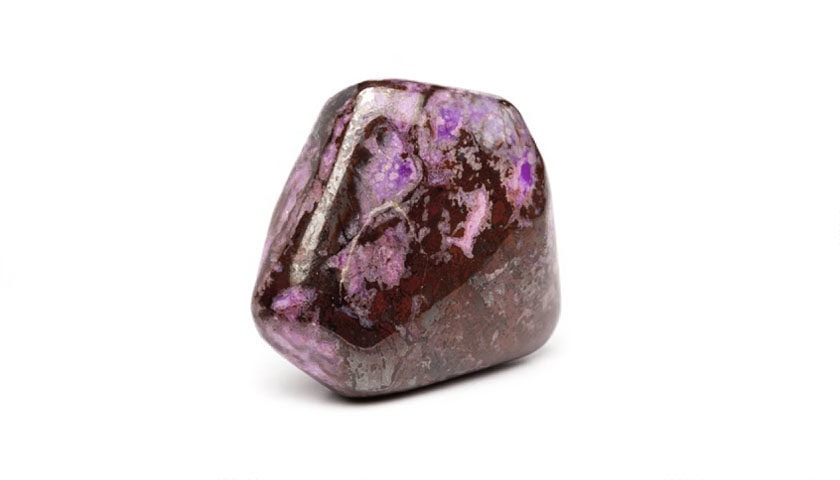Article Highlights
- Typically formed through the metamorphism of manganese-bearing sediments and metasomatism, Bustamite tells a story of deep earth processes over millions of years.
- It stands out with its pink to brownish-red hues, a hardness of 5.5 to 6.5 on the Mohs scale
- Named after Mexican mineralogist Miguel Bustamante y Septiem, the type locality is the Franklin Mine, Franklin, Sussex County, New Jersey, US.
The Marvel of Bustamite’s Metamorphosis
Alright, let’s dive into the world of Bustamite. This mineral is an extraordinary member of the wollastonite group, and a high-temperature polymorph of CaMnSi2O6. It means Bustamite can transform its form depending on temperature, similar to how water morphs into ice or steam. This fascinating transition between Bustamite and its low-temperature counterpart, Johannsenite, happens at a scorching 830°C (1,530°F).
An International Mineral
Unlike other minerals, Bustamite sure loves to travel. From the bustling streets of Franklin, New Jersey, to the expansive outbacks of Broken Hill, New South Wales, Australia, it has journeyed to all corners of the world. Each of these locations has a unique geological tale to tell, with Bustamite playing a crucial role.
Bustamite’s Epic Journey
Picture a setting billions of years ago, deep within the Earth. It’s incredibly hot, the pressure is intense, and there’s an abundance of sediment. This is where Bustamite begins its journey. The oldest rocks at the Franklin site, for example, are Precambrian gneisses. These rocks were uplifted and transformed over time, depicting a geological roller-coaster ride spanning millions of years, with Bustamite in the center of it all!
The Aesthetic Allure of Bustamite: Physical Properties

Bustamite is a true spectacle. Its colors range from a soft, blush pink to a bold, brownish-red. This mineral has a vitreous luster and a streak of white. On the hardness scale, it measures between 5.5 to 6.5, making it a relatively tough mineral. Furthermore, it’s translucent to transparent, with a specific gravity between 3.32 and 3.43.
The Naming of Bustamite: An Homage to Miguel Bustamante y Septiem
In a twist of events, Bustamite was named after a Mexican mineralogist and botanist, Miguel Bustamante y Septiem. Initially, the type locality was designated as Tetela de Jonotla, Puebla, Mexico. However, this material was later found to be a blend of johannsenite and rhodonite. Therefore, the type locality has been relocated to the Franklin Mine, Franklin, Sussex County, New Jersey, US.
Bustamite in the Wild: Diverse Localities and Appearances
Bustamite can often be mistaken for Friedelite and Rhodonite due to its similar reddish to pinkish hues. This mineral is globally distributed and found in a plethora of places, from Mexico to Sweden, England to Japan. Faceted gems of Bustamite are incredibly rare and often small, whereas cat’s eye material is also scarce but available.
Reclaiming Bustamite: A Tale of Resemblance and Reuse
The story of Bustamite took an interesting turn when its name was re-used in 1922 for a mineral somewhat chemically similar to the original material, which was actually a blend of rhodonite and johannsenite. The name Bustamite was retained to honor Miguel Bustamante y Septiem (1790–1844), a renowned Mexican mineralogist.
Bustamite Metaphysical Properties

The Spiritual Significance of Bustamite
Feel the pull of something mystical? That’s just the captivating energy of Bustamite! Not only is it a fascinating mineral from a geological standpoint, but it’s also known for its potent metaphysical properties. Let’s embark on an enchanting journey to explore the spiritual essence of this beautiful stone.
Your Healing Companion: Bustamite’s Role in Emotional Healing
The magic of Bustamite lies in its phenomenal emotional healing properties. Imagine a warm, gentle energy swirling around you, dissipating tension and stress, and replacing it with a sense of calm and serenity. That’s the soothing balm of Bustamite working its healing magic.
Like a trusted friend, Bustamite lends a hand during tumultuous times, grounding us when we’re feeling scattered. Picture a tree, its roots extending deep into the earth, stable and steadfast. That’s the kind of grounding Bustamite brings.
Bustamite: A Gateway to Enhanced Intuition
Bustamite is often regarded as a beacon for enhanced intuition. Imagine a subtle, inner voice guiding you towards your path of fulfillment. The alluring energy of Bustamite can help attune you to this inner wisdom, opening doors to unseen worlds.
A Resonance of Love: Bustamite and the Heart Chakra
On the energetic level, Bustamite is closely aligned with the Heart Chakra. Picture a vibrant, spinning wheel of green energy in the center of your chest, radiating love and compassion – that’s your Heart Chakra. With its gentle pink hues, Bustamite connects beautifully with this energy center, promoting a profound sense of love, empathy, and understanding.
Astrological Connections: Bustamite’s Celestial Alliances
Now, let’s take a peek at Bustamite’s connection with the cosmos. Astrologically speaking, Bustamite shares a strong bond with the passionate sign of Scorpio. So, if you’re a Scorpio, Bustamite might just be your perfect energetic ally.
Awaken Inner Peace: Meditative Magic with Bustamite
Imagine a tranquil space, a haven of calm where the world outside ceases to exist. This is the sacred space we enter when we meditate, and Bustamite can serve as our guide in this spiritual journey.
Let’s paint a picture here. You’re sitting comfortably, the calming pink hues of a Bustamite crystal resting in your hand. As you close your eyes and tune into your breath, you sense the gentle, grounding energy of the stone, guiding you to a state of deep relaxation. You’re not just meditating; you’re harmonizing your energy with the healing vibrations of the universe, facilitated by the beautiful Bustamite.
This stone, with its serene vibes, makes an ideal companion for those seeking to deepen their meditation practice. Its unique energy signature helps to clear away mental clutter, allowing for a peaceful, focused state of mind. With Bustamite by your side, you’re not just meditating – you’re embarking on a journey of inner tranquility and heightened awareness.
Your Secret Ingredient for Feng Shui
Now, imagine a space where energy flows smoothly, unimpeded by clutter or discordant vibrations. Welcome to the world of Feng Shui, where Bustamite can play a starring role!
The energy of a room significantly affects those inhabiting it. Bustamite, with its gentle, nurturing vibes, helps to harmonize this energy, creating a balanced and peaceful environment. This stone resonates with love and compassion, transforming any space into a cozy sanctuary.
Picture it now. A Bustamite stone placed in a strategic location, its soft pink hues radiating tranquility and inviting harmonious energy. Not only does it beautify the space, but it also uplifts the energy, creating an atmosphere of peace and positivity. So, why not add a touch of Feng Shui magic to your space with Bustamite?
Cultivating Harmony: Bustamite at Home and Work
Bustamite isn’t limited to just meditation and Feng Shui; it can also be an ally in promoting positivity and productivity at home and work.
Imagine sitting at your desk, a piece of Bustamite by your side. Its soothing presence calms your mind, aiding concentration and sparking creativity. It’s not just a stone; it’s a grounding force that helps you navigate through the ebb and flow of daily tasks.
And let’s not forget the home. Bustamite’s energy of love and compassion makes it a great fit for promoting harmony and understanding within a family. Picture a Bustamite crystal placed in the living room, casting a warm, tranquil aura. It’s not just home decor; it’s a beacon of peace, anchoring harmonious energy and fostering a nurturing environment.
Frequently Asked Questions About Bustamite
What is Bustamite?
Bustamite is a calcium manganese inosilicate mineral, a member of the wollastonite group.
Where is Bustamite found?
Bustamite has been found in various locations around the world including the USA, Australia, Japan, South Africa, Sweden, and England.
What color is Bustamite?
Bustamite typically presents in light pink to brownish-red hues, although the pink color tends to fade on exposure to sunlight.
Who was Bustamite named after?
Bustamite was named after the Mexican mineralogist and botanist Miguel Bustamante y Septiem (1790–1844).
How is Bustamite formed?
Bustamite usually results from the metamorphism of manganese-bearing sediments, with a side of metasomatism, a process that takes place deep within the Earth, under conditions of intense heat and pressure.
How hard is Bustamite?
On the Mohs scale, Bustamite has a hardness of 5.5 to 6.5, making it a relatively hard mineral.
What are the metaphysical properties of Bustamite?
Metaphysically, Bustamite is believed to possess potent emotional healing properties. It is often associated with grounding energy and enhancing intuition.
Is Bustamite rare?
Bustamite isn’t the most common mineral, but it has been found in various corners of the world.
Can Bustamite be used in jewelry?
Yes, Bustamite is often seen as beautiful reddish to pinkish cabochons. It’s also used in bead form for necklaces and bracelets.
Does Bustamite change color?
The pink color of Bustamite tends to fade on exposure to sunlight.
What’s the difference between Bustamite and Rhodonite?
While both Bustamite and Rhodonite may present similar pink hues, they are different minerals with unique chemical compositions and crystal structures.
| Bustamite Physical Properties | |
|---|---|
| Crystal Structure | Triclinic |
| Mineral Class | Wollastonite Group |
| Specific Gravity | 3.32-3.43 |
| Formula | CaMnSi2O6 |
| Hardness | 5.5-6.5 |
| Transparency | Translucent to Transparent |
| Chemical Composition | Calcium Manganese Inosilicate |
| Locations | USA, Australia, Japan, South Africa, Sweden, England |
| Rarity | Uncommon |
| Can Be Submerged in Water | Yes |
| Sun Safe Crystal | No |
| Special Care Instructions | Keep out of direct sunlight, avoid harsh chemicals when cleaning |
| Price | $10 – $100 per piece |
| Bustamite Metaphysical Properties | |
|---|---|
| Chakras | Heart Chakra |
| Zodiac Signs | Scorpio |
| Planets | Mars |
| Numerical Vibration | 9 |
| Elements | Earth |
| Symbolism | Love, Healing, Growth |
| Birthstones | Not a traditional birthstone |
| Affirmations | “I am connected to all around me.” |
| Emotional Conditions | Anxiety, Stress, Emotional Trauma |
| Spiritual Purposes | Grounding, Energy Cleansing, Meditation |
| Crystal Combinations | Rhodonite, Sugulite |



